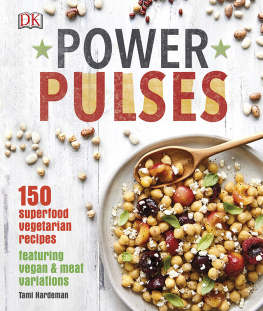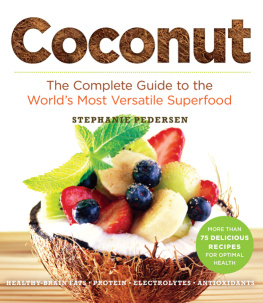STERLING and the distinctive Sterling logo are registered trademarks of Sterling Publishing Co., Inc.
All rights reserved. No part of this publication may be reproduced, stored in a retrieval system, or transmitted in any form or by any means (including electronic, mechanical, photocopying, recording, or otherwise) without prior written permission from the publisher.
For information about custom editions, special sales, and premium and corporate purchases, please contact Sterling Special Sales at 800-805-5489 or .
FOREWORD
As the director of Colon Cancer Prevention at UConn Health, I oversee a program that offers patients entry into a clinical study of early-stage abnormal growths in the colon, among other things. Patients who consent to the study fill out a questionnaire that asks for a breakdown of their tree nut consumption. Patients also provide a blood specimen and answer a series of demographic questions about their overall health and risk factors for colon cancer, such as their BMI, waist-to-hip ratio, smoking history, and NSAID intake. The patient is then provided with a state-of-the-art colonoscopy examination using a high-definition endoscope and contrast dye-spray to illuminate the bowel wall and provide images of even microscopic lesions. We remove up to ten of these lesions and then study their biology in the laboratory. We also have a number of mouse genetic models of colon cancer that we routinely use in the laboratory to gain a better understanding of the earliest stages of GI cancer. Using the models, we have defined a number of nutritional variables that may contribute to cancer risk, including the levels of folic acid.
Our interest in exploring novel ways to reduce cancer risk in people began several decades ago when the relatively new field of cancer prevention with the use of natural products and non-toxic synthetic agents (e.g., aspirin) was in its earliest days. In the 1960s the field of cancer prophylaxis was created by the insights of Dr. Lee Wattenberg. It was later refined in the 1970s by Dr. Michael B. Sporn, who coined the term cancer chemoprevention while working at the National Cancer Institute. Spurred by the realization that a wide variety of natural products could have a beneficial effect on a persons risk for developing myriad cancers, we launched our research program to find new mechanisms that could be exploited for cancer prevention. Progress in this field of research over the past few decades has been extraordinary, with many new approaches developed that may ultimately contribute to the eradication of cancer.
One such strategy that has been under intense scrutiny in recent years is the health benefit of consuming what we generally refer to as the Mediterranean Diet, a way of eating that is rich in fruits and vegetables, legumes, fish, and olive oil (Fazio and Ricciardiello, Phytochemistry Reviews, 2014). One key ingredient of the Mediterranean Diet is the tree nut. Of the various tree nuts, walnuts offer a remarkably healthy nutritional composition, including ellagitannins, vitamin E, omega-3 fatty acids, polyphenols, phytosterols, melatonin, and fiber. We have recently tested the potential for walnuts to protect against intestinal cancer using a mouse genetic model in our laboratory (Nakanishi et al., Cancer Prevention Research, 2016). We reported that walnuts added to a Western style diet loaded with a number of common fats found in the American diet and less calcium and vitamins provided protection against cancer development. Not only that, but the walnuts actually acted like a probiotic agent, causing a remarkable change to the community structure of the intestinal microbiota. We are excited by these recent findings and have initiated a series of related studies to test the beneficial effects of walnuts in a second mouse cancer model, as well as an experimental model of inflammatory bowel disease.
I believe this book is extremely timely and of great importance to the general population. Offering a natural and healthy way to potentially reduce risk of cancer by simply incorporating an outstanding nutritional source (that is, tree nuts) into your diet makes sense, both from the nutritional standpoint and from a scientific perspective.
Daniel W. Rosenberg, PhD
Professor of Medicine and Health Net, Inc.
Chair in Cancer Biology
Investigator, Center for Molecular Medicine
University of Connecticut School of Medicine
INTRODUCTION
As you read the title of this book, you might think, How can nuts be super when you consider the fat that they contain or the salt that is on them? Nuts were lauded as a key component of the diet, then feared for their fat, and have now regained favor as an element of healthy eating.
Nuts are a versatile food. You can eat them by themselves, include them in recipes, or feature them as an accent to dishes. Nuts offer a wide variety of nutrients, including protein, which makes them good additions to any eating plan. But there are two things that make them superfoods: fats and phytonutrients.
Nuts are composed of a variety of fats; and while each nut variety has a different
fat composition, they all tend to have more of the healthier, unsaturated fats. Unsaturated fats are found predominantly in plants: vegetable oils, nuts, and seeds. Unsaturated fats are liquid at room temperature; so if you were to take the fat out of a nut, it would be liquid at room temperature. Research shows that unsaturated fats provide more heart health benefits than saturated fats, including helping to lower blood cholesterol, fighting inflammation, helping with heart rhythm, and other health-promoting benefits.
All nuts contain unsaturated fat, but some have more than others. Some nuts have more of the less healthful saturated fats, and in subsequent chapters we will talk more about these differences among the nuts. Saturated fats are solid at room temperature, and consuming too much of them has been associated with an increased risk of heart disease. The ideal way to include nuts in your eating plan is to learn which ones provide more of the unsaturated fat and simply use those nuts more often. These are what I call Superfood Nuts. As you read through this book you will see that there is more evidence of the health benefits of certain nuts. This might simply be the fact that some nuts are more healthful than others, but it could also point to the types of nuts researchers choose to study or the availability of nuts for researchers to do strong enough and large enough studies.
Besides being rich in unsaturated fats, Superfood Nuts are composed of beneficial phytonutrients. Phytonutrients are plant compounds that provide health benefits beyond those provided by the vitamins and minerals contained in the food. Over the last several years research studies have looked at plant foods to try to understand why they provide so many health benefits that exceed their basic nutrition profile. Though all the answers arent in yet, research shows that phytonutrients, which make each plant food unique, are used in many different ways by the body to fight inflammation, help prevent disease, aid intestinal health, and even help with memory, among other things.













